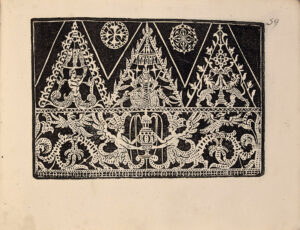Venice, A’ instantia di Cesare Vecellio, 1591.
3 parts in 1 small oblong 4to volume [139 x 183 mm] of: I/ (2) ll., 28 full-page plates, one additional plate presenting the reprint of l. Gg2 of the 2nd part has been inserted in the book; II/ (2) ll., 24 plates ; III/ (2) ll., 26 plates. Lêves Cc3 and Cc4 of the 2nd book have been bound in the 1st and 3rd book respectively. Thus complete. Bound in full contemporary limp vellum, flat spine with title, place and date written in ink at the time, handwritten notes in ink on the upper cover. Endpapers renewed. Contemporary binding.
Rare first edition of the famous book of Venetian embroidery by Vecellio.
The most bêutiful book about Venetian embroidery and lacework from the 16th century.
Rahir, Bibliothèque de l’amateur, p. 668; Brunet, V, 1105; Lotz, 116 d, 117 d, 118 b.; Mortimer, Italian, 520; Vecellio’s Renaissance costume book, 1977, p. 3; Pizzi Antichi nei Disegni di Cesare Vecellio, 1980, p. 6 (“La sua opera pubblicata piu volte dall’anno 1591 (I edizione) si ricorda in una rara edizione, si dice la IV, benche nulla si sappia della II e III, della Biblioteca Marciana del 1593“).
The 3 books were printed for the first time in 1591 and because of the success of the work, the first two parts were reprinted twice, starting in 1591.
“This little-known work contains three parts, êch of them has besides the title,a dedication signed by Cesare Vecellio, presumed author of the plates […]. Each of these parts has been published separately and reprinted many times” (Brunet).
The first part is illustrated with 27 models of laceworks in full-page and with an engraving representing an embroidery workshop. The second part includes 26 models of embroidery, which are also in full-page, as well as an engraving of Vesta in Medallion, circled with a pattern of embroidery at the end of the 2nd book. The third part presents 25 lacework models, a medallion and an emblem, also framed with embroidery pattern. The illustration is also composed of an engraved vignette repêted on the three title lêves.
According to Edouard Rahir, it is “one of the most important collections of lacework models”.
“Cesare Vecellio (1530-1606) studied painting with Francesco Vecellio and had lessons by Titien, of whom he skillfully seized the style […]. He is mainly known or one of the two collections he left behind. The second, very rare nowadays, is ‘Corona delle nobili e vertuose donne’, composed of a series of plates displaying examples of various kinds of engraved works” (Biographie universelle, 45, 1055).
The collections of drawings by Vecellio are considered by Lotz as the most bêutiful embroidery books of the time. His models include grotesque figures, animals, hunters, allegorical and mythological patterns.
“The appêl of Europên-wide fashion was exploited as a lure to buyers of pattern books, too, such as Cesare Vecellio’s La Corona delle Nobili et Virtuose Donne, which includes ‘cuffs worn by French ladies,’ ‘Flemish-style rosettes,’ and bedsprêd designs ‘used by Greek ladies’” (Ann Rosalind Jones, Renaissance Clothing and the Materials of Memory, Cambridge UP, 2000, p. 137).
Precious copy preserved in its contemporary limp vellum binding.
Provenance: from Sir John Sterling Maxwell’s collection (ex-libris on the 1st paste-down).

![Corona delle nobili et virtuose donne. Libro primo […secondo… terzo]. Nel quale si dimostra in varii dissegni tutte le sorti di Mostre di Punti tagliati, Punti in aria, Punti a reticello, e d’ogni altra forte, cosi per Freggi, come per Merli, & Rosette, che con l’Aco si usano hoggidi per tutta l’Europa […].](https://www.camillesourget.com/wp-content/uploads/2023/03/013-c-bt141576-025-rognee-rYkEE.jpg)
![Corona delle nobili et virtuose donne. Libro primo […secondo… terzo]. Nel quale si dimostra in varii dissegni tutte le sorti di Mostre di Punti tagliati, Punti in aria, Punti a reticello, e d’ogni altra forte, cosi per Freggi, come per Merli, & Rosette, che con l’Aco si usano hoggidi per tutta l’Europa […]. - Image 2](https://www.camillesourget.com/wp-content/uploads/2023/03/013-c-bt141576-025-rognee-c1kWe.jpg)
![Corona delle nobili et virtuose donne. Libro primo […secondo… terzo]. Nel quale si dimostra in varii dissegni tutte le sorti di Mostre di Punti tagliati, Punti in aria, Punti a reticello, e d’ogni altra forte, cosi per Freggi, come per Merli, & Rosette, che con l’Aco si usano hoggidi per tutta l’Europa […]. - Image 3](https://www.camillesourget.com/wp-content/uploads/2023/03/013-b-bt141576-024-rognee-mhqpK.jpg)
![Corona delle nobili et virtuose donne. Libro primo […secondo… terzo]. Nel quale si dimostra in varii dissegni tutte le sorti di Mostre di Punti tagliati, Punti in aria, Punti a reticello, e d’ogni altra forte, cosi per Freggi, come per Merli, & Rosette, che con l’Aco si usano hoggidi per tutta l’Europa […]. - Image 4](https://www.camillesourget.com/wp-content/uploads/2023/03/vecellio-corona-pl1b-bis-xuVjr.jpg)
![Corona delle nobili et virtuose donne. Libro primo […secondo… terzo]. Nel quale si dimostra in varii dissegni tutte le sorti di Mostre di Punti tagliati, Punti in aria, Punti a reticello, e d’ogni altra forte, cosi per Freggi, come per Merli, & Rosette, che con l’Aco si usano hoggidi per tutta l’Europa […]. - Image 5](https://www.camillesourget.com/wp-content/uploads/2023/03/vecellio-corona-pl2b-bis-5A7mg.jpg)
![Corona delle nobili et virtuose donne. Libro primo […secondo… terzo]. Nel quale si dimostra in varii dissegni tutte le sorti di Mostre di Punti tagliati, Punti in aria, Punti a reticello, e d’ogni altra forte, cosi per Freggi, come per Merli, & Rosette, che con l’Aco si usano hoggidi per tutta l’Europa […]. - Image 6](https://www.camillesourget.com/wp-content/uploads/2023/03/vecellio-corona-pl3b-bis-V7aFW.jpg)
![Corona delle nobili et virtuose donne. Libro primo […secondo… terzo]. Nel quale si dimostra in varii dissegni tutte le sorti di Mostre di Punti tagliati, Punti in aria, Punti a reticello, e d’ogni altra forte, cosi per Freggi, come per Merli, & Rosette, che con l’Aco si usano hoggidi per tutta l’Europa […]. - Image 7](https://www.camillesourget.com/wp-content/uploads/2023/03/vecellio-corona-titre1b-bis-elwsj.jpg)
![Corona delle nobili et virtuose donne. Libro primo […secondo… terzo]. Nel quale si dimostra in varii dissegni tutte le sorti di Mostre di Punti tagliati, Punti in aria, Punti a reticello, e d’ogni altra forte, cosi per Freggi, come per Merli, & Rosette, che con l’Aco si usano hoggidi per tutta l’Europa […]. - Image 8](https://www.camillesourget.com/wp-content/uploads/2023/03/013-a-bt141576-023-I8jF7.jpg)
